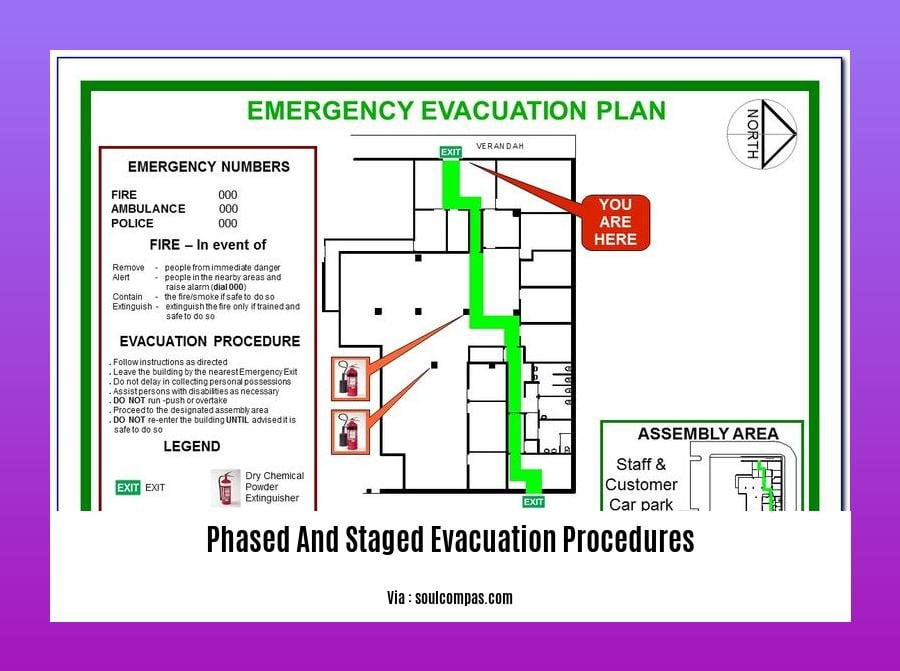Phased and Staged Evacuation Procedures for Enhanced Emergency Preparedness: An in-depth analysis of the effective implementation of phased and staged evacuation procedures for improved community resilience during emergency events.
Key Takeaways:

- Types of Evacuation: Single stage (simultaneous) and staged (multiple priorities).
- Factors Influencing Strategy: Occupancy, building size, staircase capacity.
- Phased Evacuation: Prioritizes evacuation for those closest to the fire or with mobility issues.
- Building Types: Phased evacuation suitable for larger premises with limited staircase capacity.
- Building Design: Fire-resistant materials support phased evacuation.
- Personnel: Trained fire marshals supervise evacuations.
Phased and Staged Evacuation Procedures
Phased evacuation involves evacuating in pre-determined stages, prioritizing those in immediate danger. Staged evacuation is similar but involves evacuating in sequential groups based on location or mobility.
Planning Phase
- Identify Evacuation Triggers: Establish clear criteria for triggering an evacuation.
- Develop Evacuation Plans: Create detailed plans outlining the designated evacuation routes and assembly points.
- Conduct Risk Assessments: Assess potential risks and identify vulnerable populations.
- Train Personnel: Appoint and train evacuation coordinators to oversee the process.
Implementation Phase
- Issue Evacuation Signal: Activate alarms or announce evacuation orders clearly.
- Prioritize Evacuation: Guide individuals in immediate danger or with mobility impairments out first.
- Phased Evacuation: If necessary, evacuate different sections of the building in stages to avoid congestion.
- Monitor and Assist: Evacuation coordinators monitor the evacuation process and assist individuals as needed.
Building Considerations
- Staircase Capacity: Determine the maximum number of people that can safely evacuate via stairwells.
- Building Height: Phased evacuation is typically recommended for buildings taller than 10 storeys.
- Fire-Resistant Materials: These materials can provide additional time for evacuation by delaying the spread of fire.
Advantages of Phased and Staged Evacuation Procedures
- Reduced Congestion: Prevents overcrowding on evacuation routes.
- Enhanced Safety: Prioritizes evacuation for those most at risk.
- Improved Coordination: Facilitates organized and efficient evacuation.
Disadvantages of Phased and Staged Evacuation Procedures
- Potential for Delay: Evacuating in stages may take longer than a single-stage evacuation.
- Training and Coordination: Requires extensive training and coordination among evacuation personnel.
- Building Design: May not be suitable for all building types or configurations.
Get all the evacuation routes and traffic updates to help you and your family stay safe during hurricane season.
Check out the freeway ramp metering and shoulder use for evacuations for more tips on how to evacuate safely and efficiently.
Not sure what evacuation zone you’re in? Find out here: evacuating in different hurricane evacuation zones
Evacuation Modeling and Decision-Making
Staged Evacuation for Disaster Management
Staged evacuation is a crucial strategy in disaster management, enabling the orderly and efficient evacuation of large populations. Leveraging evacuation modeling and decision-making, authorities can optimize evacuation plans and make informed choices to enhance community safety during emergencies.
Key Takeaways:
- Mitigating Congestion: Staged evacuation effectively reduces traffic congestion by scheduling the evacuation of different groups in a phased manner.
- Optimizing Evacuation Schedules: Evacuation modeling utilizes bi-level frameworks to determine the optimal evacuation schedule for various population groups.
- Simulating Human Behavior: Evacuation models accurately simulate human behavior during emergencies, accounting for route selection and collision avoidance.
- Supporting Decision-Making: Integrated scenario-based frameworks assist decision-makers in hurricane evacuation planning by incorporating multiple scenarios.
- Comprehensive Planning: Evacuation plans should incorporate evacuation zones, transportation models, and community lifeline considerations.
By embracing evacuation modeling and decision-making, emergency management professionals can enhance evacuation preparedness, ensuring the safety and well-being of communities during disasters.
Citation:
- Determining Optimum Staged-Evacuation Schedule Considering Total Evacuation Time
Interagency Coordination and Best Practices
When disaster strikes, effective interagency coordination is paramount for successful emergency response and recovery. Coordinated efforts among various agencies, organizations, and community groups ensure a comprehensive and efficient approach to disaster management.
Key Takeaways:
- Foster Communication Channels: Establish clear and reliable communication channels between all stakeholders involved in emergency response.
- Develop Interagency Agreements: Formalize agreements outlining roles, responsibilities, and protocols for interagency cooperation.
- Conduct Joint Training Exercises: Engage in regular exercises to practice coordination and response strategies, fostering familiarity and collaboration among agencies.
- Share Resources and Information: Facilitate the exchange of resources, data, and best practices to enhance situational awareness and decision-making.
- Establish Unified Command Structures: Implement a unified command system to ensure clear decision-making and coordination of resources during emergencies.
Benefits of Interagency Coordination:
- Improved decision-making and resource allocation
- Enhanced response times and efficiency
- Increased community engagement and trust
- Reduced duplication of efforts and wasted resources
Best Practices for Interagency Coordination:
- Foster Collaboration: Build relationships and trust among agencies through regular communication and engagement.
- Establish Clear Roles and Responsibilities: Define the specific roles and responsibilities of each agency involved in emergency response.
- Develop Comprehensive Response Plans: Create detailed plans that outline coordination strategies, communication protocols, and resource sharing mechanisms.
- Conduct Regular Training Exercises: Simulate emergency scenarios to test coordination procedures and identify areas for improvement.
- Evaluate and Improve: Continuously monitor and evaluate interagency coordination efforts to identify successes and areas for further enhancement.
Citation:
Interagency Security Committee. (2010). Developing and Maintaining Emergency Operations Plans.











